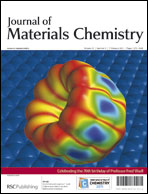A series of new donor–bridge–acceptor dyads with high chemical, electrochemical, thermal and conformational stability were synthesized by Stille coupling of oligo(3,4-ethylenedioxy)thiophenes (nEDOTs) and 1,4,5,8-naphthalenetetracarboxydiimide (NDI) building blocks. The molecular design provides for complete separation of HOMO and LUMO orbitals. A thiol functionality allows for selective anchoring of the dyads to metal electrodes, through either the donor or acceptor sides of the molecule. The optoelectronic properties of the dyads, both in solution and in self-assembled monolayers on gold, were characterized by electrochemistry, spectroelectrochemistry and UV-Vis absorption/emission spectroscopy and the results were further supported by DFT calculations.
You have access to this article
 Please wait while we load your content...
Something went wrong. Try again?
Please wait while we load your content...
Something went wrong. Try again?


 Please wait while we load your content...
Please wait while we load your content...